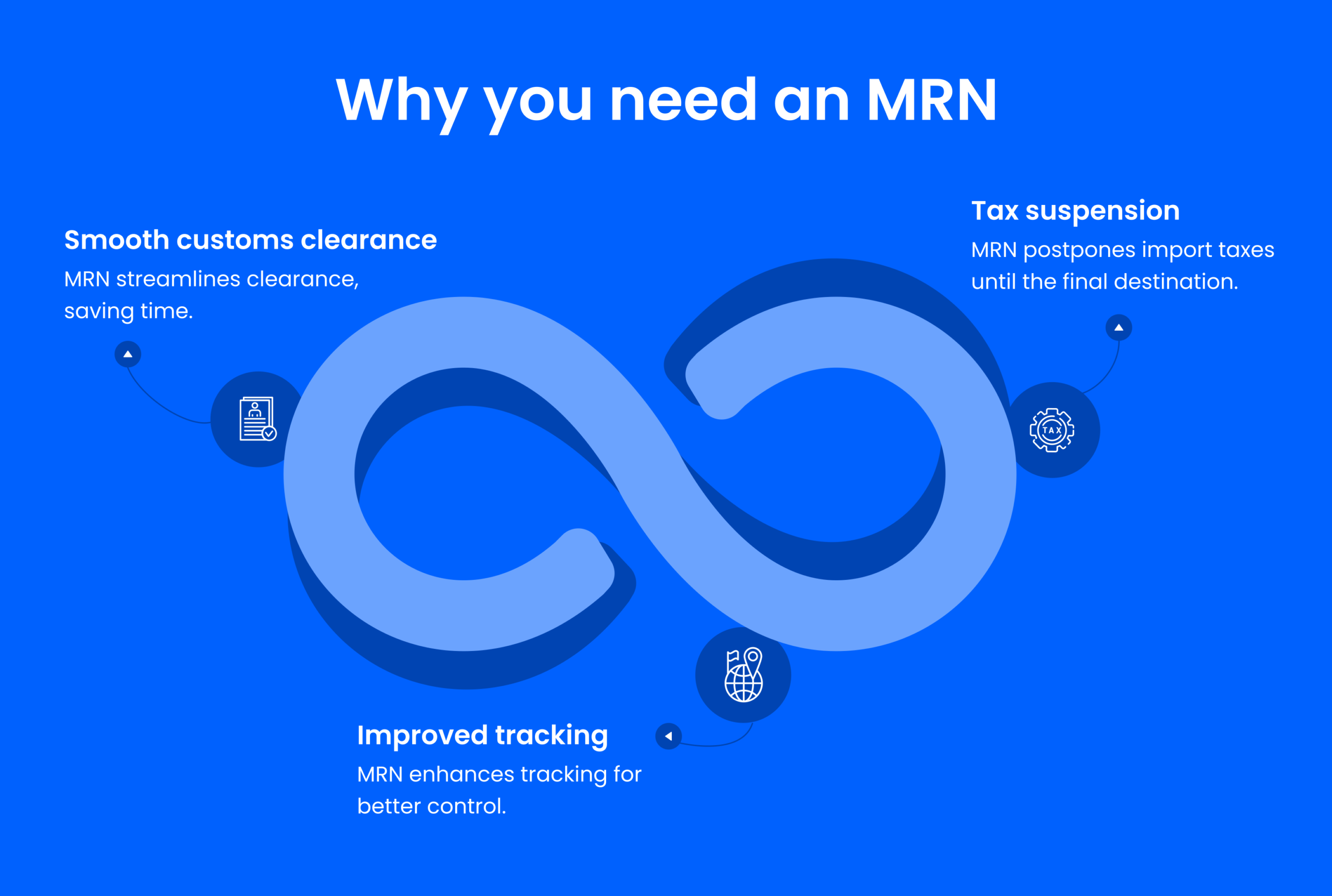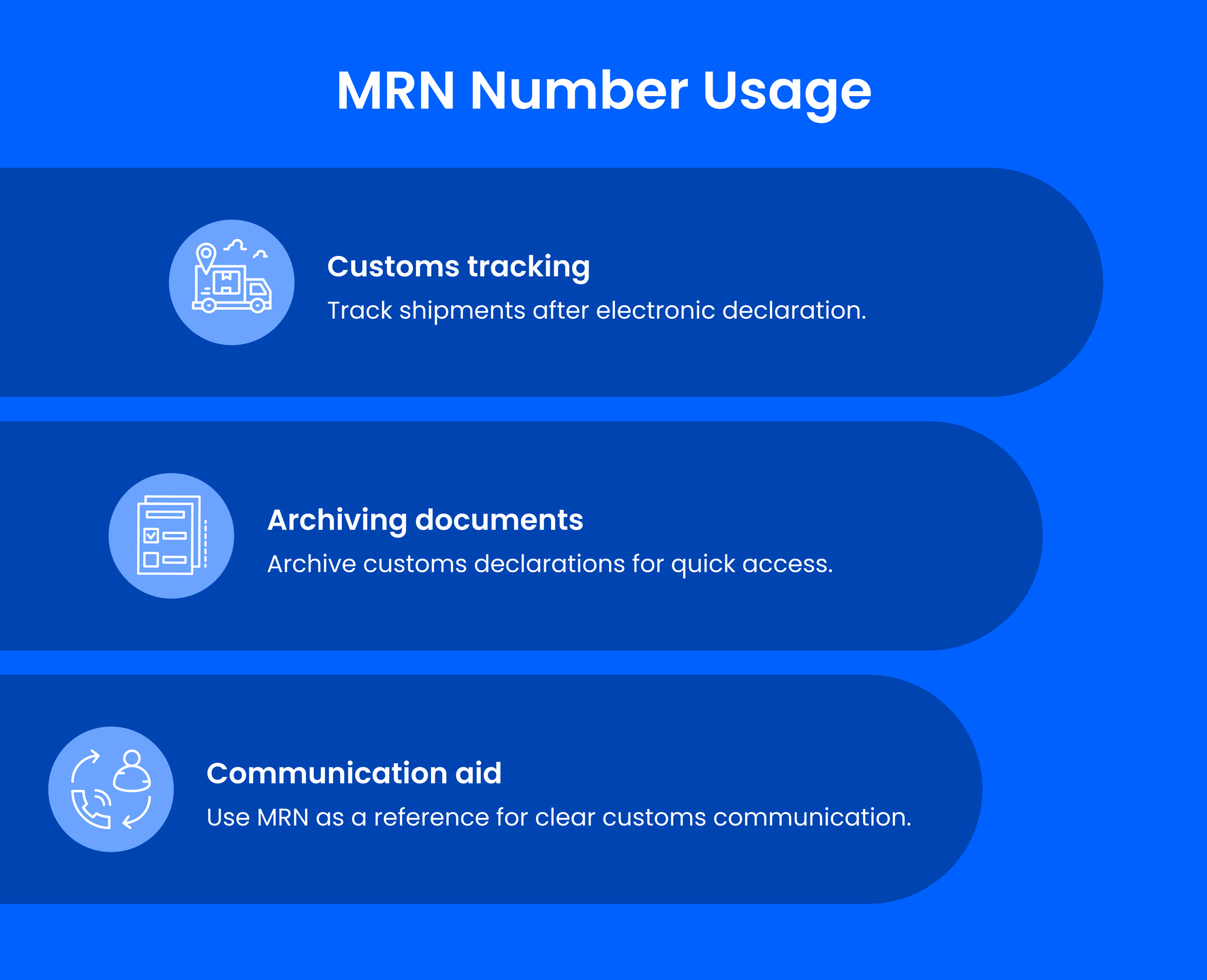Fast & Accurate ENS GB & EU ICS2 Solutions Built for You.
What is a Movement Reference Number ( MRN Number ) on CDS?
-
Freya Jane
- Director of Customer's Success
An essential component of international trade, the Movement Reference Number (MRN) acts as a distinct identification for import and export customs declarations. This distinct number simplifies customs declaration processes and guarantees the efficient movement of products across borders. Since the introduction of the MRN number, customs clearance times have reduced considerably. Moreover, businesses involved in global commerce should expect significant savings and enhanced logistical efficiency as a result.
The method of making customs declarations is changing for importers and exporters. With the introduction of Customs Declaration Service (CDS) in place of Customs Handling Import and Export Freight (CHIEF), you need to use a Movement Reference Number (MRN) when submitting your declarations.
In this blog post, we will walk you through every possible aspect of MRN on CDS.
What is an MRN number?
A movement Reference Number, or MRN, is a customs registration number issued by customs authorities to manage the shipment process and serve as a primary reference number for customs declarations. Every time an import or export declaration is submitted in the UK or EU, a unique number is assigned to it that is referred to as a goods movement reference number.
The import and export declaration MRN number is used for electronic declarations in ATLAS (Automated Tariff and Trade System) or similar systems.
Movement Reference Number (MRN) on CDS
When a declaration is submitted on CDS for the purpose of importing or exporting goods, a customs identification number (MRN) is generated. The customised number produced enables a unique connection between your goods and you. Consequently, MRNs are a critical component of the audit procedure pertaining to your declarations.
Why do I need MRN?

Customs processes may be somewhat complicated when moving products among EU member states. Traders use the Movement Reference Number to improve the efficiency and effectiveness of cross-border commodity movement.
The reasons why you need an MRN are as follows:
Smooth and faster customs clearance
Each customs declaration is assigned a unique identity, which is determined by MRN. It streamlines the customs clearance process at the final destination by electronically linking your cargo with the necessary authorities. In doing so, it helps traders save considerable time and resources by not having to undergo customs inspection at each border crossing.
Taxes and duties suspension
An important benefit of the MRN system is the ability to temporarily halt import taxes and tariffs. So long as the items don’t enter the customs territory at their final destination, these taxes can be postponed. For businesses engaged in global commerce, this suspension might be very advantageous to their cash flow.
Improved tracking and management
The MRN system provides better tracking and management of products by making their movement more transparent. By employing the MRN, customs officials may easily monitor the shipment’s whereabouts, which improves their ability to keep control of it during transit and guarantees compliance with rules.

Speed up customs clearance, calculate accurate duties, and improve management with iCustoms.
What is the MRN number used for?

The MRN is used for the following purposes:
Customs declaration tracking: The MRN number tracking helps businesses and customs authorities track the shipment after the customs declaration has been submitted electronically.
Archiving and documentation: The businesses involved in international trades can use MRN numbers to archive and document their customs declarations. This helps them quickly provide the required documents in case of any inspections from customs authorities.
Communication with customs authorities: In the event that doubts or uncertainties emerge concerning a customs declaration, the MRN number functions as a point of reference to guarantee that all parties are communicating about the same procedure.
What are the benefits of MRN in international trade?
Transparency: The customs MRN number ensures transparent tracking of the shipments, thus facilitating communication between customs authorities, freight forwarders, and businesses.
Improved efficiency: The MRN number serves as a unique identifier for customs declaration, allowing the goods to be processed and released more quickly.
Error reduction: A unique MRN number is assigned to each customs declaration, reducing the chances of mixing ups and errors.
Reduce errors and enhance transparency & productivity with iCustoms. Start Now!
What characters constitute the MRN number?
As per the UK Govt.,
“The Movement Reference Number (MRN) is an ID consisting of 18 characters, a combination of letters and numbers.”
- Alphanumeric Reference: A 14-character code which is generated in CDS.
- Country code: It is a 2-digit geographical code. For instance, it is shown as “GB” for the United Kingdom.
- Year: It is a 2-digit code; for 2024, it becomes “24”.
How is an MRN number assigned?
CDS issues a unique MRN number for each customs declaration. This number is automatically generated for all the export and import declarations submitted to CDS. The MRN can be viewed in your commercial software as a part of the initial notification response to the declaration submission. In the event that your declaration is denied and upon successful resubmission, a new MRN will be generated.
Importance of the MRN Number in Customs Clearance
Customs declaration proof: The Movement Reference Number (MRN) confirms that a shipment’s declaration has been successfully submitted.
Status monitoring: The MRN number enables customs authorities and traders to track the status of their shipments.
Customs control simplification: The customs inspection is made easier with the MRN number as all the relevant documents and information are readily accessible.
Essential for customs clearance: A valid export MRN number is required for customs management and clearance; imports cannot be cleared for customs without one.
FAQ's
What is the MRN on a customs declaration?
MRN stands for Movement Reference Number. Customs authorities issue MRNs and use them to process and track shipments.
Where can I find my customs MRN number?
To get a goods movement reference number, submit an import or export declaration to CDS, and it will automatically generate the customs MRN number.
When should a CDS generated MRN not be used?
When filing export declarations for goods passing via an inventory-linked maritime location, you should not use the MRN generated by CDS as a reference. Conversely, it is mandatory to utilise the Declaration Unique Consignment Reference (DUCR).
Is MRN a tracking number?
Yes, a Movement Reference Number (MRN) is a tracking number used by businesses and customs authorities to track shipments.
You may also like:
Simplify Customs Clearance with our Powerful CDS Software
Automate declarations, track shipments with MRN, & ensure compliance.
Subscribe to our Newsletter
About iCustoms
Simplify Customs Clearance with our Powerful CDS Software
Automate declarations, track shipments with MRN, & ensure compliance.


